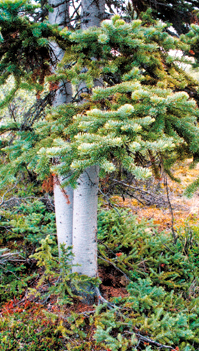Yukon's territorial symbols
The westernmost and smallest of Canada’s three federal territories, Yukon was split from the Northwest Territories in 1898.
Origin of the name
The territory’s name probably comes from the word “Yu-kun-ah” meaning “great river.” In 1846, chief trader John Bell of the Hudson’s Bay Company canoed down the Porcupine River to where it meets the Yukon River. There, he met natives who told him that the name of the big river was the “youcon”. The Yukon River is the fifth longest in North America.
Population (2006): 31,200
Area: Land – 478,970 km2Fresh water – 4,480 km2Total – 483,450 km2Capital: WhitehorseDate of entry into Confederation: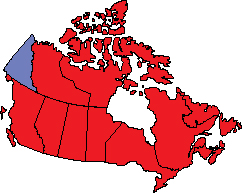
History
Yukon was probably the first area in Canada to be settled, following the migration of the ancestors of First Nations people across the Bering Strait land bridge from Asia to North America some 4,000 years ago. Language is central to Yukon First Nation heritage. The history and traditions of the many Yukon First Nations have been passed down through the generations orally by the teachings of elders. There are seven Athapaskan languages spoken in Yukon: Gwich’in, Han, Kaska, Tagish, Upper Tanana, Northern and Southern Tutchone. Tlingit is also spoken in southwestern Yukon.
John Franklin became the first European to reach Yukon in 1825 – then part of Rupert’s Land – when he followed the Arctic coastline in search of the Northwest Passage. By 1848, the Hudson’s Bay Company had established four trading posts on a traditional First Nation trading route.
In 1870, the Government of Canada acquired the territory from the Hudson’s Bay Company and the entire region became known as the Northwest Territories. The boundaries of Yukon were first drawn in 1895, when it became a district of the Northwest Territories. Because of its remote location and severe climate, Yukon’s population remained sparse until the discovery of gold.
After gold was discovered at Rabbit Creek (later renamed Bonanza Creek) in 1896, the Klondike area became one of the most populated regions in the northwestern part of the continent as thousands of hopeful gold seekers headed north. By 1898-1899, Dawson City, at the junction of the Klondike and Yukon rivers, was home to 40,000 people.
The sudden increase in population during the Klondike Gold Rush prompted the federal government to exert stronger control in Yukon. It became a separate territory in 1898 with the passage of the Yukon Act. Dawson was chosen as the new territory’s capital city. In 1953, the capital was moved to Whitehorse, the territory’s most populous city and the centre of its economic activity.
Between 1896 and 1903, more than $95 million in gold were mined from the Klondike region. But once the easily extracted placer gold was depleted, Dawson’s population dropped to 8,512 by 1911. Today, its population is approximately 1,200. However, the Klondike is still a major tourist attraction in Yukon. August 17, “Discovery Day,” is an annual holiday celebrating the anniversary of the initial discovery of gold at Bonanza Creek.
When Yukon became a separate territory, the Yukon Act of 1898 provided for a Commissioner and a legislative council of six, all appointed by the Government of Canada. In subsequent years, elected officials were included on the council; the first wholly elected council was elected in 1909.
In 1979, an executive committee was established to assist the Territorial Commissioner in the executive function, and the elected members of the Executive Committee or Council have progressively assumed greater responsibilities. With the formal introduction of party politics in 1978, the elected leader of the majority party in the legislature became known as the Government Leader. When responsible government was established in 1979, the Commissioner no longer participated in the Executive Council. The Government Leader has the authority to determine the size and the appointments to the Executive Council, much like the premiers in the provinces.
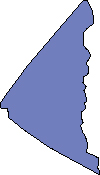
Coat of arms
The Yukon coat of arms was granted by Queen Elizabeth II and adopted by the Yukon Legislative Council in 1956. The Cross of St. George at the top of the shield refers to the early explorers and fur traders from England, while the round panel of heraldic fur in the centre of the cross symbolizes the fur trade. The wavy white and blue vertical stripes in the lower part of the shield represent the Yukon River and gold-bearing creeks of the Klondike. The red spire-like forms represent the mountains of Yukon, and the two gold discs in each spire, the territory’s mineral resources. The crest above the shield features a malamute (or husky) dog standing on a mound of snow.

Flag
The Yukon flag was adopted by the Territorial Council in 1967. The flag is made up of three vertical panels. The green panel on the staff side symbolizes the forests, the white in the centre, the snow, and the deep blue on the fly side, Yukon’s rivers and lakes. The centre panel features the territorial coat of arms and floral emblem, the fireweed.
The flag was designed by Lynn Lambert, a student from Haines Junction, Yukon, who won the territorial design competition during Canada’s centennial year. The flag’s proportions are two by length and one by width.
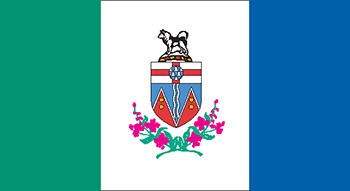
Floral emblem
Fireweed (Epilobium angustifolium) was chosen as Yukon’s floral emblem in 1957. It is a hardy plant and grows along Yukon roadsides, river bars and clearings from mid-July to September. Its blooms are a bright magenta, making it one of the most attractive plants in the North. It’s also one of the first plants to appear after a forest fire.
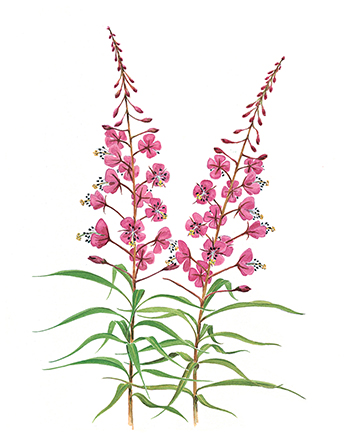
Other territorial symbols
Bird
The raven was adopted as Yukon’s official bird in 1985 and it is seen everywhere in Yukon. It is a very intelligent bird and an opportunistic feeder, feasting on everything from carrion to groceries left in the back of pick-up trucks.
The raven is the largest member of the crow family and has a body length of up to 70 centimetres.
The raven is called “crow” by Yukon First Nations people and is the subject of many stories passed from generation to generation.
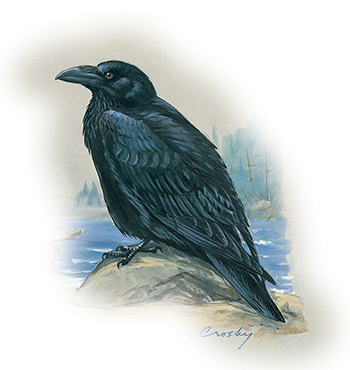
Gemstone
Lazulite is an azure-blue semi-precious gemstone. A rare and beautiful phosphorous-based mineral, it was proclaimed as Yukon’s official gemstone in 1976. It is the only semi-precious gemstone found in any quantity in the territory.
Well-formed crystals of the gemstone occur in only a few places in the world. In Yukon, lazulite is found in the layered sedimentary rock of the Blow River area in Ivvavik National Park. The colour and crystalline qualities of Yukon’s lazulite are among the finest in the world.
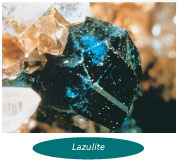
Tartan
The Yukon tartan was designed in 1965 by Janet Couture, of Faro, and was officially registered by Lord Lyon, King of Arms of Her Majesty's General Register House at Edinburgh in 1984.
Yukoner’s pride in the territory is reflected in the brilliant colours of the tartan: the blue represents the sparkling, glacier-fed waters and clear mountain skies; magenta, the colour of the floral emblem; green, the great expanses of wilderness forest; purple, the majestic mountains; white, the purity of the winter snow; and yellow, the long, soft evenings of the midnight sun, and the territory’s famous deposits of gold.
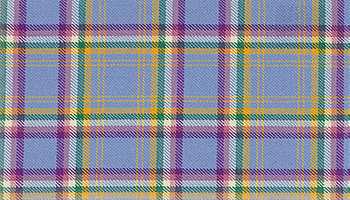
Tree
Selected as Yukon’s official tree in 2001, the subalpine fir (Abies lasiocarpa) can range from six to 20 metres tall and is found in the regions south of Dawson City and east of Haines Junction. The tree usually grows at higher elevations, and its short, stiff branches slope downward, allowing it to withstand heavy loads of snow and ice in the high country.
The needles of subalpine fir produce a lemony tasting tea, which is a traditional First Nations cold remedy rich in vitamin C. Sap drawn from the blisters on its bark has been used by First Nation people as a traditional medicine for lung ailments.
